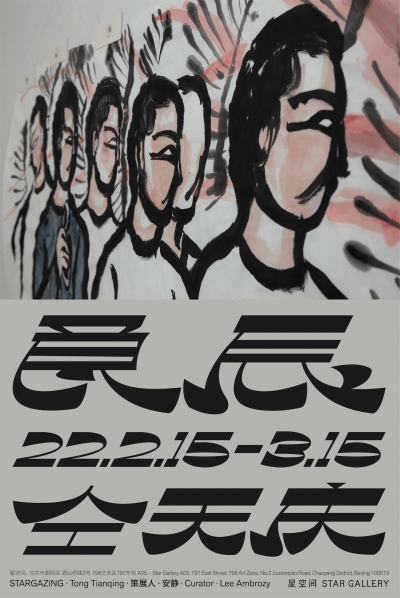
Introduction by Curator Lee Ambrozy
On February 15, 2022, the night of the Lantern Festival, Star Gallery Beijing will present Tong Tianqing’s most monumental exhibition to date, "Stargazing." In these mural-like works, Tong mines the dichotomies of timelessness and specificity, us and them, material fragility and timeless allegories, to bring us a hard-hitting celebration of everyday people, their rituals, and spectatorship. Here, in a straightforward style and installed with minimalist mounting, Tong presents ten new works over two series. The imposing, large-format ink on rice paper works are hung directly on the wall, enhancing their mural-like qualities. Their unusual subjects—dogfights at the Yangzhen market bazaar and the afterlife of human remains—are vignettes taken from his magnum opus artist book, Sea of Bitterness, folios of which are displayed in the adjoining room. In addition, Tong celebrates the Year of the Tiger with handcrafted, painted lanterns, and a painting heroic tiger in the gallery hallway.
His third exhibition with the gallery, “Stargazing” is the next iteration of text and image based ink practices Tong deftly explored in previous exhibitions "Rid of Horror” (2017) and “Brine: An Artist Book by Tong Tianqing” (2015). His new works bring us into the milieu of quotidian life, which he documents in his practice.
Tong Tianqing is well known for his calligraphic practice and journals documenting travels, observations, and experiences in and around Beijing. He has devoted himself to demonstrating the relevance of traditional ink-based arts in modern China, and to contemporizing ink figure painting. Using a style legible to a broad audience that encompasses both academy elite and those people whose lives he chronicles, Tong draws on the legacies of Bada Shanren, Qi Baishi, Feng Zikai, and even Song monumental landscapists such as Fan Kuan in depicting a spectrum of characters from mythological figures to peasants. His unembellished brushwork and compositions draw from pictorial traditions of folk art, literati painting, and Socialist Realism. Here, he merges his craft with the scale, monumentality, and immersive qualities of mural painting.
The exhibition centers around seven paintings depicting greyhounds chasing and devouring rabbits alongside the human perpetrators and spectators of this gruesome ritual. At 2.4 × 3.1 meters, the larger-than-life figures surround the distinctly Beijing, light-flooded gallery with its saw-tooth, Bauhaus-style windows. The series’ ambitious attempt at scale is enabled by advancements in rice paper manufacture, which allows for single sheets of paper of unprecedented proportions. In the adjacent room, three paintings of equal scale document contemporary crematorium practices, an inevitable postmortem reality for everyone living and dying in China.
Tong Tianqing's application of color is considered, layered, and reserved. After translation into ink lines and mineral pigments, the harshness of his subject matter feels mitigated by his uncomplicated style. However, the reductive qualities of his brushwork do not diminish his paintings’ impact. We become lost in the textures of the dogs' lithe frames, the bleeding saturation of red "blood" spots, and the wrinkled brown pants of the spectators. Using the power of minimalist lines, meditative repetition, and wintry hues, Tong weaves fascinating visual and psychological complexity into his artworks' surfaces.
In these expansive flat white rice paper surfaces we see native plant species and animals that add spatial depth to the works and site-specificity that native Beijingers will appreciate. The schematic facial features and the bird and flower elements in his compositions recall religious painting or Buddhist geometry—and overlapping with mural traditions. Suspended between Tong's decorative surfaces and the psychic depths of their worlds are scenes that deliver both ruthlessness and the picturesque.
How do we reconcile subjects as art world narratives? By presenting them as aestheticized subjects, Tong Tianqing makes ink practice contemporary; through this culturally specific medium and its embedded histories, he translates the energetic rush of spectatorship from the Yangzhen market bazaar into the art gallery, where it feels out of place. In doing so he reminds us that we are no different than the crowds on these walls.
About the curator
A specialist in Chinese art from the ninth through eleventh centuries, Lee Ambrozy is a Ph.D. candidate at New York University’s Institute of Fine Arts, where her research examines how images from nature circulated within early urban China’s art and material culture. She has more than fifteen years of expertise working with contemporary art within China, and obtained her M.A. at Beijing’s Central Academy of Fine Arts with a thesis discussing the nationalist uses of traditional ink painting under Mao. She was editor of the first publication of seminal modern art texts in Chinese, Inside the White Cube: Artforum Fifty years of Art Criticism (Sanlian Books, 2017). She is currently based in Detroit, where she writes, curates exhibitions, and translates on occasion, adapting to the changing cultural landscape in the Post-Pandemic world.
About the exhibition
Dates: Feb 15, 2022 - Mar 15, 2022
Venue: Star Gallery
Courtesy of the Artist and Star Gallery.




























